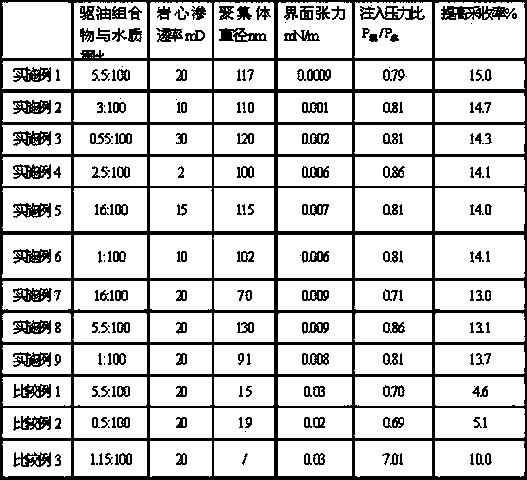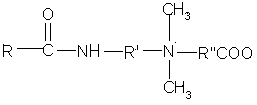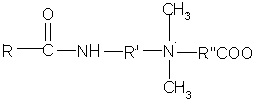Oil displacement composition used for low permeability oil reservoirs, and preparation method thereof
An oil displacement method and a low-permeability technology, which are applied in the field of oil-displacing compositions for low-permeability oil reservoirs and their preparation, can solve problems such as difficulty in injection and formation blockage, and achieve the effects of improving oil displacement efficiency and overcoming cohesion.
- Summary
- Abstract
- Description
- Claims
- Application Information
AI Technical Summary
Problems solved by technology
Method used
Image
Examples
Embodiment 1
[0031] Put 9-octadecenoic acid and N,N-dimethyl-1,4-butanediamine into the reaction kettle in a molar ratio of 1:1.5, stir at 165°C for 8h, and then remove the residue by vacuuming with an oil pump at 165°C. The content of the reacted N,N-dimethyl-1,4-butanediamine is 99.0wt% as determined by liquid chromatography. Then add 4-chlorobutyrate to the above system according to the molar ratio of 9-octadecenoic acid and 4-sodium chlorobutyrate of 1:1.5, and react with 85 ° C for 6 hours. After the reaction is completed, wash with absolute ethanol to remove After the unreacted sodium 4-chlorobutyrate was evaporated to remove the solvent, octadecenamide butyl betaine was obtained, and the content was 97.0 wt%.
[0032] Mix octadecenamide butyl betaine and NaCl in a mass ratio of 1:10 to form an oil displacement composition. The oil displacement composition and water are mixed uniformly in a mass ratio of 5.5:100. The size of the micelles formed by ZS90 was measured at 25 °C, and the...
Embodiment 2
[0037] Put 12-tetracosenoic acid and N,N-dimethyl-1,2-ethylenediamine into the reaction kettle according to the molar ratio of 1:3, stir at 160°C for 10h, and then remove the oil pump vacuum at 165°C The content of unreacted N,N-dimethyl-1,2-ethylenediamine was 98.9wt% as determined by liquid chromatography. Then add sodium 2-chloroethyl sulfonate to the above system according to the molar ratio of 12-tetracosenoic acid and sodium 2-chloroethyl sulfonate of 1:3, and react with 80 ° C for 10 h. After the reaction is completed, use The unreacted sodium 2-chloroethyl sulfonate is removed by washing with absolute ethanol, and the solvent is evaporated to obtain tetraenamidoethyl betaine with a content of 97.1 wt%.
[0038] Combining tetraenamidoethyl betaine with CaCl 2 The oil displacement composition was mixed according to the mass ratio of 1:5. The oil displacement composition was evenly mixed with water according to the mass ratio of 3:100. The size of the micelles formed at ...
Embodiment 3
[0043] 7,15-Tridecenoic acid and N,N-dimethyl-1,2-ethylenediamine were put into the reaction kettle according to the molar ratio of 1:2, stirred at 170°C for 20h, and then evacuated by oil pump at 165°C After removing unreacted N,N-dimethyl-1,2-ethylenediamine, the content of triaconenamide ethylenediamine was determined by liquid chromatography to be 99.0wt%. Then add sodium chloromethanesulfonate to the above system according to the molar ratio of 7,15-tridecenoic acid and sodium chloromethanesulfonate of 1:1.5, and react with 95 ° C for 3 hours. After the reaction, wash with absolute ethanol to remove After the unreacted sodium chloromethanesulfonate was evaporated to remove the solvent, the trienamidoethyl betaine was obtained, and the content was 97.3 wt%.
[0044] Combining Triaconamidoethyl Betaine with NaHCO 3 The oil displacement composition was mixed according to the mass ratio of 1:2. The oil displacement composition was mixed with water according to the mass ratio...
PUM
 Login to View More
Login to View More Abstract
Description
Claims
Application Information
 Login to View More
Login to View More - R&D
- Intellectual Property
- Life Sciences
- Materials
- Tech Scout
- Unparalleled Data Quality
- Higher Quality Content
- 60% Fewer Hallucinations
Browse by: Latest US Patents, China's latest patents, Technical Efficacy Thesaurus, Application Domain, Technology Topic, Popular Technical Reports.
© 2025 PatSnap. All rights reserved.Legal|Privacy policy|Modern Slavery Act Transparency Statement|Sitemap|About US| Contact US: help@patsnap.com



